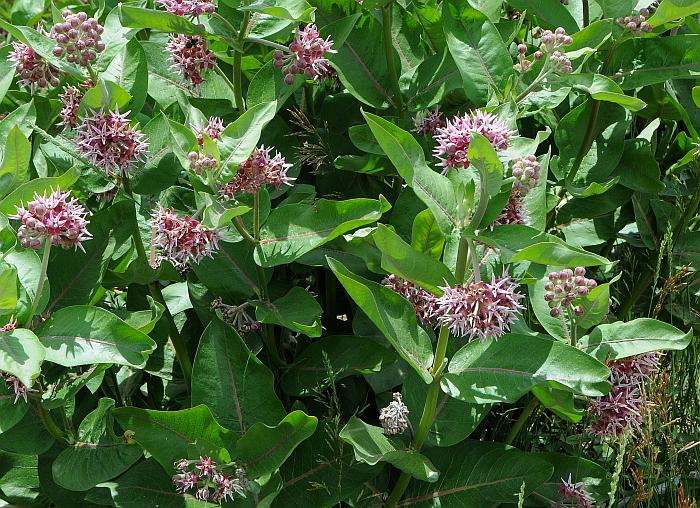Asclepias speciosa Torr.
Showy Milkweed

Native
CC = *
CW = 0
MOC = 2
© SRTurner
Asclepias speciosa Torr.Showy Milkweed | |
 |
Native CC = * CW = 0 MOC = 2 |
© SRTurner |
|
Family - Asclepiadaceae Habit - Perennial herb with deep rhizomes and milky latex. Stems - Ascending to erect, to 1 m, usually unbranched, densely short-hairy at least toward the tip, with 7 to numerous nodes.
Leaves - Opposite, simple, sessile or short-petiolate. Blades 6-20 cm long, 2.5-10 cm wide, lanceolate to ovate or oblong-elliptic, the base rounded to shallowly cordate, the tip narrowed or tapered to a sharp point, less commonly rounded but with a short, sharp point, the margins flat, the upper surface sparsely to densely short-hairy, especially along the midvein, the undersurface densely short-hairy.
Inflorescences - Umbellate clusters, 1-6 per stem, terminal and in the upper leaf axils, usually long-stalked, with 10-40 flowers.
Flowers - Calyces reflexed, densely short-hairy on the outer surface, the lobes 4.0-6.5 mm long, lanceolate to ovate. Corollas reflexed, moderately to densely short-hairy on the outer surface except for a thin, glabrous, marginal band, purplish pink or greenish purple, the lobes 9-15 mm long, lanceolate to oblong-lanceolate. Gynostegium appearing very short-stalked (the column barely visible below the bases of the hoods), pale pink to cream-colored, the corona conspicuously longer than the tip of the anther/stigma head. Corona hoods 9-15 mm long, spreading to loosely ascending, attached near their bases, abruptly narrowed below the middle, the apical half narrowly lanceolate to lanceolate in outline, the tip tapered to a sharp point, the margins with a pair of triangular teeth or lobes at or below the middle, the bases not pouched. Horns attached toward the hood bases, arched over the anther/stigma head but not extended past the tips of the hoods, linear, not flattened, tapered to a sharp point at the tip.
Fruits - Follicles 7-12 cm long, erect or ascending from deflexed stalks, ovate and slightly arched in outline, the surface with soft, narrow, warty tubercles and densely hairy (woolly). Seeds with the body 6-9 mm long, the margins narrowly to relatively broadly winged, the terminal tuft of hairs white to light cream-colored or tan.
Flowering - May - August. Habitat - Open areas. Origin - Native to the U.S. Lookalikes - Asclepias sullivantii, possibly A. syriaca. Other info. - This showy milkweed is rare in Missouri and may not even currently exist in the state. Its last collection here was in Boone County in 1933. Missouri would represent the extreme eastern extent of the plant's range, which extents from Kansas to the west coast. In these regions it is quite common. The plant is easily recognized by its large, deep pink flowers and leaves which are densely hairy underneath. The floral hoods in particular are long-tapered, longer than those of other milkweeds in Missouri. These are the five whitish structures around the perimeter of each flower in the images above. Photographs taken in Rocky Mountain National Park, Larimer County, CO, 7-10-2014 and 8-2-2017, and in Carbon County, UT, 6-20-2015 (SRTurner). Photo of fruit courtesy of Kathy Bildner, 8-2-2023. |